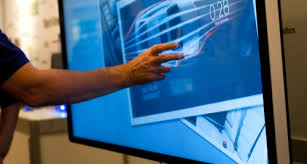Touchscreens and connected objects
- Volkmar Kunerth
- Jan 5, 2021
- 2 min read
After smartphones and tablets, TVs, PCs and appliances are now being touched.
The display market is about to experience a second revolution. After the advent of flat screens, the market for touch screens is about to conquer new territories. The touchscreen market is expected to reach nearly $35 billion in sales in 2020, according to DisplaySearch. That's twice as much as in 2011 and six times as much as in 2009. Apple, with the launch of the iPhone in 2007, started the movement.
Touchscreens were popularized by smartphones and then by tablets. They will continue to benefit from the expansion of these markets and the development of other applications; initially in PCs. The launch of Windows 10, Microsoft's new software, is expected to result in a surge in the number of PC models - fixed or portable - equipped with touch screens. In July, Microsoft acquired Perceptive Pixel, one of the pioneers of the touch screen technology. One of the particularities of this company is that it manufactures very large touch screens.
Touch screen tablets can be used as interactive tables for presentations or lessons, but also as a tactile touch table. This path is also explored by Samsung with its Surface (equipped with Windows). In a bar, it allows to check a menu, place an order, start a communication... A touch screen tablet application can be much more useful: to help to configure a car in a dealership, to make a demonstration for a real estate loan, or to help an architect to present his plans.
Ease of use
Ultimately, televisions could also be tactile. LG regularly presents such prototypes on which it is possible to draw with a stylus. But apart from the entertainment component, the value of having a touchscreen TV in your living room has yet to be demonstrated.
Consumer electronics as a whole has converted to touch screens. Digital cameras are increasingly equipped with them, as are GPS devices and printers. The ease of use provided by this type of screen makes it easier to spread it to other types of equipment. Large household appliances such as ovens, refrigerators or high-end washing machines are increasingly equipped with touch screens. Smaller food preparation appliances are following suit. The display allows you to choose a program. Coupled with an Internet connection, it can also give access to recipes adapted to the appliance used.
Manufacturers of educational toys have also entered the world of touch. Vtech, one of the leaders in the sector, has launched its InnoPad, a (very resistant) tablet for 3-6 year olds. LeapFrog has also taken a turn, preferring to make its LeapPad 2 a tablet rather than an interactive book.
Nonetheless, the growth in the supply of touchscreens remains below production. According to Display Search, nearly 100 suppliers are competing for this market. Only two-thirds of them are capable of producing multi-touch screens, i.e. they can respond to several requests. And this is one of the main challenges of this market.













Comments